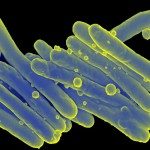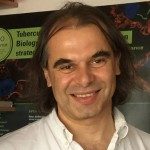Link to Pubmed [PMID] – 27859892
Mol. Microbiol. 103(1):7-12.
Interactive link to publication: http://onlinelibrary.wiley.com/wol1/doi/10.1111/mmi.13579/abstract
Abstract
Mycobacterium tuberculosis, the etiological agent of human tuberculosis harbours five ESAT-6/type VII secretion (ESX/T7S) systems. The first esx gene clusters were identified during the genome-sequencing project of M. tuberculosis H37Rv. Follow-up studies revealed additional genes playing important roles in ESX/T7S systems. Among the latter genes, one can find those that encode Pro-Glu (PE) and Pro-Pro-Glu (PPE) proteins as well as a gene cluster that is encoded > 260 kb upstream of the esx-1 locus and encodes ESX-1 secretion-associated proteins EspA (Rv3616c), EspC (Rv3615c) and EspD (Rv3614c). The espACD cluster has been suggested to have an important function in ESX-1 secretion since EspA-EspC and EsxA–EsxB are mutually co-dependent on each other for secretion. However, the molecular mechanism of this co-dependence and interaction between the substrates remained unknown. In this issue of Molecular Microbiology, Lou and colleagues show that EspC forms high-molecular weight polymerization complexes that resemble selected components of type II, III and/or IV secretion systems of Gram-negative bacteria. Indeed, EspC-multimeric complexes form filamentous structures that could well represent a secretion needle of ESX-1 type VII secretion systems. This exciting observation opens new avenues for research to discover and characterize ESX/T7S components and elucidates the co-dependence of EsxA/B secretion with EspA/C.

